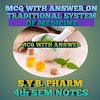NOVEL HERBAL DOSAGE FORMS (PART - 2)
NOVEL HERBAL FORMULATION
Topics covered:-
- Liposomes
- Pharmacosomes
- Nanoparticles
2. LIPOSOMES:-
WHAT IS A LIPOSOME:-
Liposomes are simple
microscopic vesicles in which an aqueous
volume
is entirely enclosed by a Phospholipids bilayer molecule.
The
size of a liposome ranges from some 20 nm up to several
micrometers.
COMPOSITION OF
LIPOSOME:- The main components
of liposomes are…..
1. Phospholipids
2. Cholesterol
PHOSPHOLIPIDS:- Phospholipids are the basic molecular building
block of the liposome.
Phospholipids is a lipid which is Amphiphatic
which consist of - 1 hydrophilic polar head
2 hydrophobic
tails hence have affinity for both aqueous and polar moiety
i.e. both
hydrophilic drugs can be encapsulated in the aqueous
phase and hydrophobic drug
molecules can be incorporated
in the lipid bilayers. Most commonly used phospholipid is
- Phosphotidylcholine or PC – phosphatidylethanolamine.
CHOLESTROL:- Role of cholesterol
in bilayer formation….
1. Cholesterol acts as
fluidity buffer.
2. After intercalation
with phospholipids molecules alter the freedom of motion of carbon molecules in
the acyl chain.
3. Restricts the
transformation of trans to gauche conformation.
4. Enhances the
stability of the membrane.
5. Enhances the rigidity
of the phospholipid bilayer
6. Reduces the
permeability of water soluble substance
The liposomes are spherical particles that encapsulate a fraction of
the solvent, in
which they freely pass around or float into their interior.
They can carry one, several, or
multiple concentric membranes.
Liposomes are constructed of polar lipids, which are
characterized by having a
lipophilic and hydrophilic group of the same molecules. On
interaction with water,
polar lipids self-layup and form self-organized
colloidal particles.
Liposome-based drug delivery systems offer the potential
to raise the therapeutic index
of anticancer agents,
by increasing the drug concentration in tumor cells or by lessening
the
exposure in normal tissues exploiting enhanced permeability and retention
effect
phenomenon or by utilizing targeting strategies.
ADVANTAGES:- The primary
advantages of using liposomes include....
1. The high
biocompatibility,
2. The easiness of
preparation,
3. The chemical
versatility that allows the loading of hydrophilic, amphiphilic, and lipophilic compounds, and
4. The simple modulation
of their pharmacokinetic properties by varying the chemical composition of the
player components.
Some examples of herbal liposomes and there application.
3. PHARMACOSOMES:-
Pharmacosomes is derived from the word “Pharmakon “which means drug and “soma“meaning carrier. It means a vesicular system in which the drug is associated with the carrier.
Pharmacosomes are defined as colloidal dispersions of drugs covalently bound to lipids and
may exist as ultrafine vesicular, micellar or hexagonal aggregates, depending on the
chemical structure of drug-lipid complex
In the pharmacosomes, the prodrug conjoins hydrophilic and lipophilic properties, and
therefore acquires amphiphilic characters. Similar to other vesicle forming components, it
was found to reduce interfacial tension and at higher concentrations exhibits mesomorphic
behaviour.
These lipid conjugated vesicles may exist as colloidal, nanometre size micelles, vesicles or
may be in the form of hexagonal assembly enjoying a functional hydrogen atom banking
upon the architecture of the complex. The drug molecule with a free carboxylic or
functional hydrogen atom like amino, hydroxyl groups is converted to an ester with the
help of the hydroxyl moiety of the lipid, resulting in the formation of a prodrug.
The prodrug possesses both hydrophilic and lipophilic properties. Despite these
properties, prodrugs have the capability to reduce interfacial tension, increase the area of
contact, and hence improve bioavailability.
They aid the deportation through the cell membrane, cell wall, and tissues. If the
concentration is increased beyond a level, it may exist in an intermediate state between the
liquid and the crystal.
4. NANOPARTICLES:-
Nanoparticles are solid colloidal particles ranging from 1 to 1000 nm in size, they consist ofmacromolecular materials in which the active ingredients (drug or biologically active material) is
dissolved, entrapped, or encapsulated, or adsorbed.
Definition Nanocapsules: in which the drug is confined to an aqueous or oily core
surrounded by a shell-like wall. Alternatively, the drug can be covalently attached to the
surface or into the matrix.
Nanoparticles are efficient delivery systems for the delivery of both hydrophilic and
hydrophobic drugs. The major goal behind designing nanoparticle as a delivery
arrangement is to control particle size, surface properties, and release of
pharmacologically active agents in order to achieve the site-specific action of the drug at
the therapeutically optimal rate and dose regimen.
Two types of nanoparticles….
1. Nanospheres
2. Nanocapsules
TYPES OF NANOPARTICLES
The nanospheres have a matrix type structure in which the active
ingredient is dispersed throughout (the molecules), whereas the nanocapsules have a polymeric
membrane and an active ingredient core (Membrane wall structure with an oil
core containing drug).
ADVANTAGES:-
1) Nanoparticle drug carriers have higher stabilities.
2) Nanoparticles have higher carrier capacity.
3) Feasibility of incorporation of both hydrophilic and
hydrophobic substances.
4) Feasibility of variable routes of administration.
5) Nanoparticles are biodegradable, non-toxic and capable
of being stored for longer
periods.
6) Nanoparticles can also be used for controlled delivery
of drug.
DISADVANTAGES:-
1) Polymeric nanoparticles posses limited drug-loading
capacity
2) On repeated administration, toxic metabolites may be
formed during the
biotransformation of polymeric carriers.
3) The polymeric nanoparticles are relatively slowly
biodegradable which might cause
systemic toxicity.

















0 Comments
Please do not enter any spam link in the comment box.